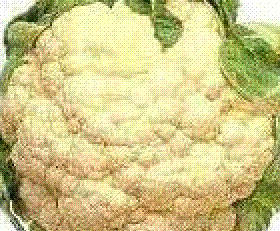

Cauliflower is a variety (Botrytis Group) of Brassica oleracea in the family Brassicaceae. It is an annual plant that reproduces by seeds. Cauliflower resembles broccoli, to which it is closely related, except with very densely packed white flower buds. Typically, only the head (the white curd) is eaten while the stalk and surrounding thick, green leaves are discarded. Cauliflower is most commonly eaten cooked, but it may also be eaten raw or pickled.
Cauliflower is low in fat, high in fiber, folate, water and vitamin C, possessing a very high nutritional density. As a member of the brassica family, Cauliflower shares with broccoli and cabbage several phytochemicals which are beneficial to human health, including sulforaphane, an anti-cancer compound released when cauliflower is chopped or chewed. In addition the compound indole-3-carbinol, which appears to work as an anti-estrogen, appears to slow or prevent the growth of tumors of the breast and prostate.[2] Cauliflower also contains other glucosinolates besides sulfurophane, substances which may improve the liver's ability to detoxify carcinogenic substances.[3]
Cauliflower also contain compounds which can be harmful to certain individuals, including goitrogens which suppress the functioning of the thyroid gland, and purine which is broken down into uric acid and can cause or aggravate gout or kidney stones.[3]
Cauliflower can be boiled, steamed or eaten raw. When cooking, the outer leaves and thick stalks are removed, leaving only the florets. These should be broken into similar-sized pieces so the florets are cooked evenly. After eight minutes of steaming or five minutes of boiling the florets should be soft, but not mushy (depending on size). Stirring while cooking can break the florets into smaller, uneven pieces. Cauliflower is often served with a cheese sauce (Cauliflower cheese)or gravy. The leaves are also edible, but are most often discarded.[4] Cauliflower can be very successfully mashed and pur
| < Prev | Next > |
|---|
















